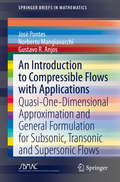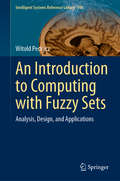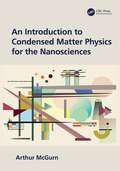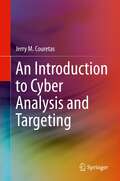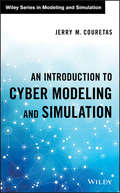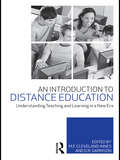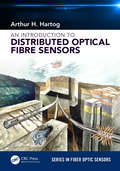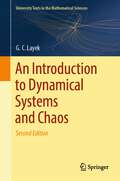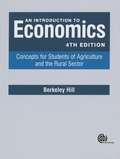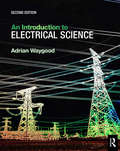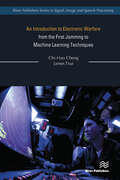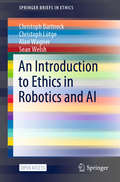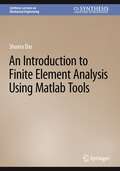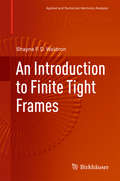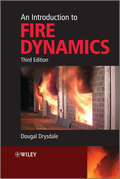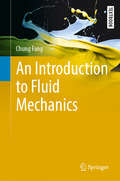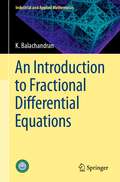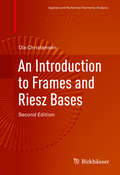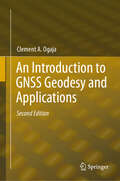- Table View
- List View
An Introduction to Compressible Flow
by Forrest E. Ames Clement C. TangAn Introduction to Compressible Flow, Second Edition covers the material typical of a single-semester course in compressible flow. The book begins with a brief review of thermodynamics and control volume fluid dynamics, then proceeds to cover isentropic flow, normal shock waves, shock tubes, oblique shock waves, Prandtl-Meyer expansion fans, Fanno-line flow, Rayleigh-line flow, and conical shock waves. The book includes a chapter on linearized flow following chapters on oblique shocks and Prandtl-Meyer flows to appropriately ground students in this approximate method. It includes detailed appendices to support problem solutions and covers new oblique shock tables, which allow for quick and accurate solutions of flows with concave corners. The book is intended for senior undergraduate engineering students studying thermal-fluids and practicing engineers in the areas of aerospace or energy conversion. This book is also useful in providing supplemental coverage of compressible flow material in gas turbine and aerodynamics courses.
An Introduction to Compressible Flows with Applications: Quasi-One-Dimensional Approximation and General Formulation for Subsonic, Transonic and Supersonic Flows (SpringerBriefs in Mathematics)
by José Pontes Norberto Mangiavacchi Gustavo R. AnjosThis book offers a concise and practical survey of the principles governing compressible flows, along with selected applications.It starts with derivation of the time-dependent, three-dimensional equation of compressible potential flows, and a study of weak waves, including evaluation of the sound speed in gases. The following chapter addresses quasi-one-dimensional flows, the study of normal shock waves, and flow in ducts with constant cross section subjected to friction and/or heat transfer. It also investigates the effects of friction and heat transfer in ducts with variable cross section. The chapter ends by pointing to the analogy between one-dimensional compressible flows and open channel hydraulics.Further, the book discusses supersonic flows, including the study of oblique shock waves, and supersonic flows over corners and wedges. It also examines Riemann problems, numerical resolution of the wave equation, and of nonlinear hyperbolic problems, including propagation of strong waves. A subsequent chapter focuses on the small perturbation theory of subsonic, transonic and supersonic flows around slender bodies aligned or almost aligned to the uniform inflow. In particular, it explores subsonic and supersonic flows over a wavy wall. Lastly, an appendix with a short derivation of the Fluid Mechanics basic equations is included.The final chapter addresses the problem of transonic flows where both subsonic and supersonic are present. Lastly, an appendix with a short derivation of the Fluid Mechanics basic equations is included.Illustrated with several practical examples, this book is a valuable tool to understand the most fundamental mathematical principles of compressible flows. Graduate Mathematics, Physics and Engineering students as well as researchers with an interest in the aerospace sciences benefit from this work.
An Introduction to Computing with Fuzzy Sets: Analysis, Design, and Applications (Intelligent Systems Reference Library #190)
by Witold PedryczThis book provides concise yet thorough coverage of the fundamentals and technology of fuzzy sets. Readers will find a lucid and systematic introduction to the essential concepts of fuzzy set-based information granules, their processing and detailed algorithms. Timely topics and recent advances in fuzzy modeling and its principles, neurocomputing, fuzzy set estimation, granulation–degranulation, and fuzzy sets of higher type and order are discussed. In turn, a wealth of examples, case studies, problems and motivating arguments, spread throughout the text and linked with various areas of artificial intelligence, will help readers acquire a solid working knowledge. Given the book’s well-balanced combination of the theory and applied facets of fuzzy sets, it will appeal to a broad readership in both academe and industry. It is also ideally suited as a textbook for graduate and undergraduate students in science, engineering, and operations research.
An Introduction to Condensed Matter Physics for the Nanosciences
by Arthur McGurnThe book provides an accessible introduction to the principles of condensed matter physics with a focus on the nanosciences and device technologies. The basics of electronic, phononic, photonic, superconducting, optics, quantum optics, and magnetic properties are explored, and nanoscience and device materials are incorporated throughout the chapters. Many examples of the fundamental principles of condensed matter physics are taken directly from nanoscience and device applications. This book requires a background in electrodynamics, quantum mechanics, and statistical mechanics at the undergraduate level. It will be a valuable reference for advanced undergraduates and graduate students of physics, engineering, and applied mathematics. Features Contains discussions of the basic principles of quantum optics and its importance to lasers, quantum information, and quantum computation. Provides references and a further reading list to additional scientific literature so that readers can use the book as a starting point to then follow up with a more advanced treatment of the topics covered. Requires only a basic background in undergraduate electrodynamics, quantum mechanics, and statistical mechanics.
An Introduction to Cyber Analysis and Targeting
by Jerry M. CouretasThis book provides a comprehensive view of cyber operations, analysis and targeting, including operational examples viewed through a lens of conceptual models available in current technical and policy literature. Readers will gain a better understanding of how the current cyber environment developed, as well as how to describe it for future defense. The author describes cyber analysis first as a conceptual model, based on well-known operations that span from media to suspected critical infrastructure threats. He then treats the topic as an analytical problem, approached through subject matter interviews, case studies and modeled examples that provide the reader with a framework for the problem, developing metrics and proposing realistic courses of action. Provides first book to offer comprehensive coverage of cyber operations, analysis and targeting;Pulls together the various threads that make up current cyber issues, including information operations to confidentiality, integrity and availability attacks;Uses a graphical, model based, approach to describe as a coherent whole the development of cyber operations policy and leverage frameworks;Provides a method for contextualizing and understanding cyber operations.
An Introduction to Cyber Modeling and Simulation (Wiley Series in Modeling and Simulation #88)
by Jerry M. CouretasIntroduces readers to the field of cyber modeling and simulation and examines current developments in the US and internationally This book provides an overview of cyber modeling and simulation (M&S) developments. Using scenarios, courses of action (COAs), and current M&S and simulation environments, the author presents the overall information assurance process, incorporating the people, policies, processes, and technologies currently available in the field. The author ties up the various threads that currently compose cyber M&S into a coherent view of what is measurable, simulative, and usable in order to evaluate systems for assured operation. An Introduction to Cyber Modeling and Simulation provides the reader with examples of tools and technologies currently available for performing cyber modeling and simulation. It examines how decision-making processes may benefit from M&S in cyber defense. It also examines example emulators, simulators and their potential combination. The book also takes a look at corresponding verification and validation (V&V) processes, which provide the operational community with confidence in knowing that cyber models represent the real world. This book: Explores the role of cyber M&S in decision making Provides a method for contextualizing and understanding cyber risk Shows how concepts such the Risk Management Framework (RMF) leverage multiple processes and policies into a coherent whole Evaluates standards for pure IT operations, "cyber for cyber," and operational/mission cyber evaluations—"cyber for others" Develops a method for estimating both the vulnerability of the system (i.e., time to exploit) and provides an approach for mitigating risk via policy, training, and technology alternatives Uses a model-based approach An Introduction to Cyber Modeling and Simulation is a must read for all technical professionals and students wishing to expand their knowledge of cyber M&S for future professional work.
An Introduction to Distance Education: Understanding Teaching and Learning in a New Era
by M.F. Cleveland-Innes D. R. GarrisonAn Introduction to Distance Education is a comprehensive look at the field today, outlining current theories, practices and goals. The book reviews the influence of past distance education theory and practice, along with current changes. It outlines the practical skills and information that are essential to effective distance education design, delivery and navigation. This volume brings together seminal contributors who have and who are currently researching and shaping our understanding and practice of distance education. A discussion of past and present practices in higher and distance education leads to an understanding of accessible education and the appropriate use of Web 2.0 technology. Utilizing a student-guided approach, each chapter offers pedagogical features to engage and support the teaching and learning process, including: questions for reflection, review and discussion: students can use these questions as triggers for further thoughts related to the topic. Instructors can use these questions for classroom and online discussion key quotations: strategically placed throughout the text, these points act as a springboard for further reflection and classroom discussion concept definitions: central concepts discussed in the text are defined or students at the end of each chapter. A perfect textbook for educational technology Doctorate, Masters and Certificate programs, students will find An Introduction to Distance Education offers a solid foundation from which to explore and develop new approaches to designing and implementing online courses.
An Introduction to Distributed Optical Fibre Sensors (Series in Fiber Optic Sensors)
by Arthur H. HartogThis book explains physical principles, unique benefits, broad categories, implementation aspects, and performance criteria of distributed optical fiber sensors (DOFS). For each kind of sensor, the book highlights industrial applications, which range from oil and gas production to power line monitoring, plant and process engineering, environmental monitoring, industrial fire and leakage detection, and so on. The text also includes a discussion of such key areas as backscattering, launched power limitations, and receiver sensitivity, as well as a concise historical account of the field’s development.
An Introduction to Dynamical Systems and Chaos (University Texts in the Mathematical Sciences)
by G. C. LayekThis book discusses continuous and discrete nonlinear systems in systematic and sequential approaches. The unique feature of the book is its mathematical theories on flow bifurcations, nonlinear oscillations, Lie symmetry analysis of nonlinear systems, chaos theory, routes to chaos and multistable coexisting attractors. The logically structured content and sequential orientation provide readers with a global overview of the topic. A systematic mathematical approach has been adopted, featuring a multitude of detailed worked-out examples alongside comprehensive exercises. The book is useful for courses in dynamical systems and chaos and nonlinear dynamics for advanced undergraduate, graduate and research students in mathematics, physics and engineering. The second edition of the book is thoroughly revised and includes several new topics: center manifold reduction, quasi-periodic oscillations, Bogdanov–Takens, period-bubbling and Neimark–Sacker bifurcations, and dynamics on circle. The organized structures in bi-parameter plane for transitional and chaotic regimes are new active research interest and explored thoroughly. The connections of complex chaotic attractors with fractals cascades are explored in many physical systems. Chaotic attractors may attain multiple scaling factors and show scale invariance property. Finally, the ideas of multifractals and global spectrum for quantifying inhomogeneous chaotic attractors are discussed.
An Introduction to Ecological Economics
by Carol Franco Robert Costanza Herman Daly Robert Goodland Richard B Norgaard Ida Kubiszewski John H CumberlandFrom Empty-World Economics to Full-World EconomicsEcological economics explores new ways of thinking about how we manage our lives and our planet to achieve a sustainable, equitable, and prosperous future. Ecological economics extends and integrates the study and management of both "nature's household" and "humankind's household"-An Introduction to
An Introduction to Economics
by Berkeley HillThis book provides a simple but effective introduction to economics. Fully updated and revised, this fourth edition incorporates the recent changes that have taken place in the environment in which agriculture operates. Covering the impacts of the EU expansion to 28 Member States, major changes to financial support of agriculture, financial crises, economic recession and, in many countries, high levels of unemployment, it provides a rounded and up to date introduction to the subject. The inclusion of chapter-focused exercises, essay questions and further reading suggestions make this textbook an invaluable learning tool for students of agriculture, economics and related sectors.
An Introduction to Electrical Science
by Adrian WaygoodAn Introduction to Electrical Science walks readers through the subject in a logical order, providing a historical overview alongside modern electrical theory and practice. Perfect for electrical trainees both during their training and once qualified. You will be guided through the subject in a topic by topic manner with each section building upon the one that came before it. By adding context to the principles of electrical science the topics become easier to both understand and remember, providing a grounding in the subject that will remain with you for life. With a wealth of examples, images and diagrams mastering difficult concepts will be a breeze. This book also has a companion site with an extra chapter, interactive multiple choice quizzes for each chapter and more at www.www.routledge.com/cw/waygood Fully aligned to the 17th edition of the wiring regulations Free access to companion website material, including multiple-choice tests and extra chapters Two-colour layout helps navigation and highlights key points Visit the companion website at www.routledge.com/cw/waygood
An Introduction to Electrical Science
by Adrian WaygoodHeavily updated and expanded, this second edition of Adrian Waygood’s textbook provides an indispensable introduction to the science behind electrical engineering. While fully matched to the electrical science requirements of the 2330 levels 2 and 3 Certificates in Electrotechnical Technology from City & Guilds (Electrical Installation), the main purpose of this book is to develop an easy understanding of the how and why within each topic. It is aimed at those starting careers in electricity and electronics, as well as any hobbyists, with an array of new material to reflect changes in the industry. New chapters include: Electrical drawings Practical resistors Measuring instruments Basic motor action Practical capacitors Basic transformer theory The electricity supply industry …and more The author details the historical context of each main principle and offers a wealth of examples, images and diagrams, all whilst maintaining his signature conversational and accessible style. There is also a companion website, with interactive multiple choice quizzes for each chapter and more, at www.routledge.com/cw/waygood
An Introduction to Electrochemical Impedance Spectroscopy
by Ramanathan Srinivasan Fathima FasminThis book covers the fundamental aspects and the application of electrochemical impedance spectroscopy (EIS), with emphasis on a step-by-step procedure for mechanistic analysis of data. It enables the reader to learn the EIS technique, correctly acquire data from a system of interest, and effectively interpret the same. Detailed illustrations of how to validate the impedance spectra, use equivalent circuit analysis, and identify the reaction mechanism from the impedance spectra are given, supported by derivations and examples. MATLAB® programs for generating EIS data under various conditions are provided along with free online video lectures to enable easier learning. Features: Covers experimental details and nuances, data validation method, and two types of analysis – using circuit analogy and mechanistic analysis Details observations such as inductive loops and negative resistances Includes a dedicated chapter on an emerging technique (Nonlinear EIS), including code in the supplementary material illustrating simulations Discusses diffusion, constant phase element, porous electrodes, and films Contains exercise problems, MATLAB codes, PPT slide, and illustrative examples This book is aimed at senior undergraduates and advanced graduates in chemical engineering, analytical chemistry, electrochemistry, and spectroscopy.
An Introduction to Electronic Warfare; from the First Jamming to Machine Learning Techniques
by Chi-Hao Cheng James TsuiSince its creation at the beginning of World II, radars have forever transformed the practice of modern warfare. The evolution of countermeasure conducted by electronic warfare systems against radars and radars’ corresponding counter countermeasures is an intriguing technical subject. This book provides a very accessible introduction to a broad range of radar and electronic warfare technologies. The subjects covered in this book range from early radar development to later technologies such as stealthy techniques, low probability of intercept radar, and machine learning. Historical events are used to illustrate the principles of electronic warfare and to help readers to apprehend contexts under which radars and corresponding electronic warfare techniques were developed.
An Introduction to Ethics in Robotics and AI (SpringerBriefs in Ethics)
by Alan Wagner Christoph Lütge Sean Welsh Christoph BartneckThis open access book introduces the reader to the foundations of AI and ethics. It discusses issues of trust, responsibility, liability, privacy and risk. It focuses on the interaction between people and the AI systems and Robotics they use. Designed to be accessible for a broad audience, reading this book does not require prerequisite technical, legal or philosophical expertise. Throughout, the authors use examples to illustrate the issues at hand and conclude the book with a discussion on the application areas of AI and Robotics, in particular autonomous vehicles, automatic weapon systems and biased algorithms. A list of questions and further readings is also included for students willing to explore the topic further.
An Introduction to Finite Element Analysis Using Matlab Tools (Synthesis Lectures on Mechanical Engineering)
by Shuvra DasThis book is an attempt to develop a guide for the user who is interested in learning the method by doing. There is enough discussion of some of the basic theory so that the user can get a broad understanding of the process. And there are many examples with step-by-step instructions for the user to quickly develop some proficiency in using FEA. We have used Matlab and its PDE toolbox for the examples in this text. The syntax and the modeling process are easy to understand and a new user can become productive very quickly. The PDE toolbox, just like any other commercial software, can solve certain classes of problems well but is not capable of solving every type of problem. For example, it can solve linear problems but is not capable of handling non-linear problems. Being aware of the capabilities of any tool is an important lesson for the user and we have, with this book, tried to highlight that lesson as well.
An Introduction to Finite Tight Frames
by Shayne F. WaldronThis textbook is an introduction to the theory and applications of finite tight frames, an area that has developed rapidly in the last decade. Stimulating much of this growth are the applications of finite frames to diverse fields such as signal processing, quantum information theory, multivariate orthogonal polynomials, and remote sensing. Featuring exercises and MATLAB examples in each chapter, the book is well suited as a textbook for a graduate course or seminar involving finite frames. The self-contained, user-friendly presentation also makes the work useful as a self-study resource or reference for graduate students, instructors, researchers, and practitioners in pure and applied mathematics, engineering, mathematical physics, and signal processing.
An Introduction to Fire Dynamics
by Dougal Drysdale"Drysdale's book is by far the most comprehensive - everyone in the office has a copy...now including me. It holds just about everything you need to know about fire science." (Review of An Introduction to Fire Dynamics, 2nd Edition)After 25 years as a bestseller, Dougal Drysdale's classic introduction has been brought up-to-date and expanded to incorporate the latest research and experimental data. Essential reading for all involved in the field from undergraduate and postgraduate students to practising fire safety engineers and fire prevention officers, An Introduction to Fire Dynamics is unique in that it addresses the fundamentals of fire science and fire dynamics, thus providing the scientific background necessary for the development of fire safety engineering as a professional discipline.An Introduction to Fire DynamicsIncludes experimental data relevant to the understanding of fire behaviour of materials;Features numerical problems with answers illustrating the quantitative applications of the concepts presented;Extensively course-tested at Worcester Polytechnic Institute and the University of Edinburgh, and widely adopted throughout the world;Will appeal to all those working in fire safety engineering and related disciplines.
An Introduction to Fluid Mechanics (Springer Textbooks in Earth Sciences, Geography and Environment)
by Chung FangThis textbook provides a concise introduction to the mathematical theory of fluid motion with the underlying physics. Different branches of fluid mechanics are developed from general to specific topics. At the end of each chapter carefully designed problems are assigned as homework, for which selected fully worked-out solutions are provided. This book can be used for self-study, as well as in conjunction with a course in fluid mechanics.
An Introduction to Fractional Differential Equations (Industrial and Applied Mathematics)
by K. BalachandranThis is an introductory-level text on fractional calculus and fractional differential equations. Targeted to graduate students of mathematics and researchers, it contains several new definitions of fractional integrals and fractional derivatives. With interesting applications of the subject in several areas of physical sciences, life sciences, engineering, and technology, the book helps the students understand the importance and developments of this topic. The book is enriched with a list of useful references to published literature, and the presentation of the book is entirely new and easily comprehensible to the students. Some of the topics are refined, and new examples are included to supplement theories to help students understand the concepts easily and clearly.
An Introduction to Frames and Riesz Bases (Applied and Numerical Harmonic Analysis)
by Ole ChristensenThis revised and expanded monograph presents the general theory for frames and Riesz bases in Hilbert spaces as well as its concrete realizations within Gabor analysis, wavelet analysis, and generalized shift-invariant systems. Compared with the first edition, more emphasis is put on explicit constructions with attractive properties. Based on the exiting development of frame theory over the last decade, this second edition now includes new sections on the rapidly growing fields of LCA groups, generalized shift-invariant systems, duality theory for as well Gabor frames as wavelet frames, and open problems in the field. Key features include: *Elementary introduction to frame theory in finite-dimensional spaces * Basic results presented in an accessible way for both pure and applied mathematicians * Extensive exercises make the work suitable as a textbook for use in graduate courses * Full proofs includ ed in introductory chapters; only basic knowledge of functional analysis required * Explicit constructions of frames and dual pairs of frames, with applications and connections to time-frequency analysis, wavelets, and generalized shift-invariant systems * Discussion of frames on LCA groups and the concrete realizations in terms of Gabor systems on the elementary groups; connections to sampling theory * Selected research topics presented with recommendations for more advanced topics and further readin g * Open problems to stimulate further research An Introduction to Frames and Riesz Bases will be of interest to graduate students and researchers working in pure and applied mathematics, mathematical physics, and engineering. Professionals working in digital signal processing who wish to understand the theory behind many modern signal processing tools may also find this book a useful self-study reference. Review of the first edition: "Ole Christensen's An Introduction to Frames and Riesz Bases is a first-rate introduction to the field . . . . The book provides an excellent exposition of these topics. The material is broad enough to pique the interest of many readers, the included exercises supply some interesting challenges, and the coverage provides enough background for those new to the subject to begin conducting original research. " -- Eric S. Weber, American Mathematical Monthly, Vol. 112, February, 2005
An Introduction to Fundamentals of Diffusion in Solid State Materials
by Reza GhomashchiDiffusion, the movement of atoms in a material, is an integral part of many metallurgical and materials treatment processes. Understanding diffusion mechanisms helps to control and improve materials properties. This book offers a comprehensive overview of diffusion in the synthesis and analysis of materials (metals and non‑metals) from the fundamentals through applications. Discusses defects in materials, fundamentals of the diffusion process, and different diffusion mechanisms active in metallic alloys Describes diffusion within non‑metallic materials, including ceramics, polymers, and semiconducting materials, with special emphasis on silicon Covers diffusion along high‑energy paths, short‑circuiting diffusion, such as grain boundaries, dislocations, and materials surface Explores diffusion under thermal and electrical gradients and explains how this information is useful for materials purification Details the application of diffusion on carbides during the thermal and thermomechanical treatments of steels Includes problems and solutions for each chapter to reinforce reader’s comprehension Written with less emphasis on complex mathematical equations, this text is accessible to researchers and students in materials, mechanical, and related engineering disciplines studying the phenomenon of diffusion in materials and its application in the engineering of materials.
An Introduction to GNSS Geodesy and Applications
by Clement A. OgajaThis volume is the second edition to 2022’s Introduction to GNSS Geodesy: Foundations of Precise Positioning Using Global Navigation Satellite Systems. It serves as an important reference to GNSS beginners as well as seasoned enthusiasts. In this updated edition, author Clement Ogaja focuses on fundamentals and contents that will remain unaffected by rapid changes and data exchange formats, ensuring that the book will remain up to date for years. The book consists of five chapters. The first covers basic concepts of parameter estimation in GNSS Geodesy. From there, Chapter 2 discusses reference systems in GNSS Geodesy. Chapter 3 moves on to observation models, errors, and biases, and Chapter 4, which is completely new to this second edition, details GNSS data processing workflow and strategies. The book concludes with an applied chapter that details concrete uses of GNSS Geodesy. New appendices that will be especially useful to seasoned users are also featured.
An Introduction to Geosynthetic Engineering
by Sanjay Kumar ShuklaThe development of the use of polymeric materials in the form of geosynthetics has brought about major changes in the civil engineering industry. Geosynthetics are available in a wide range of compositions appropriate to different applications and environments. Over the past three to four decades, civil engineers have grown increasingly interested

